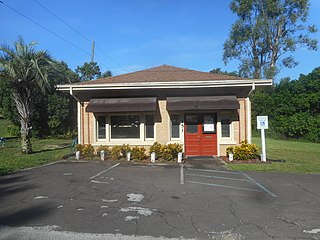
Frostproof is a city in Polk County, Florida, United States. The city is located in southern Polk County on the Lake Wales Ridge. It is part of the Lakeland–Winter Haven Metropolitan Statistical Area. The population was 2,877 at the 2020 census.

Hillcrest Heights is a town in Polk County, Florida, United States. Hillcrest Heights is part of the Lakeland–Winter Haven Metropolitan Statistical Area. The population was 243 at the 2020 census.

Lake Wales is a city in Polk County, Florida. It is part of the Lakeland–Winter Haven Metropolitan Statistical Area. The population was 16,361 at the 2020 census.

The Plant City High School is a public high school in Plant City, Florida, United States and is part of the Hillsborough County Public Schools. The current school building was completed in 1972 on Maki Road, now called Raider Place.

Ben Hill Griffin Jr. was a prominent American businessman, citrus producer, politician, and philanthropist who was a native and resident of Florida. He was an alumnus of the University of Florida, a former legislator, one-time candidate for governor, and a patron of college sports and higher education in Florida. Several of his grandchildren remain active in Florida politics. Griffin is the subject of the final chapter of John McPhee's work of creative nonfiction Oranges.

Norman Hall is a historic academic building on the eastern campus of the University of Florida in Gainesville, Florida. It was designed by architect Rudolph Weaver in the Collegiate Gothic style, and built in 1932. It originally housed the university's research and development primary and secondary schools, but now is the principal building of the university's College of Education. It is located on U.S. 441, near the southwest corner of S.W. 3rd Avenue and S.W. 12th Street in Gainesville. On January 26, 1990, it was added to the U.S. National Register of Historic Places.

The original Columbia County High School is a historic building in Lake City, Florida, United States, located at 372 West Duval Street. It is now the location of Columbia County School District administrative offices. It was built in 1921 and was the only high school in Columbia County. When enrollment exceeded capacity, it was replaced in 1957 by a larger facility on Pennsylvania Avenue, which was named Columbia High School. The original high school was used as the school board administrative offices for a time, then converted into Lake City Junior High School in the mid-1970s. It was the site of serial killer Ted Bundy's abduction of 12 year old Kimberly Leach on February 9, 1978. There had been reports of a white van circling the building. Bundy abducted Leach as she left the side door of the main building, facing towards Southwest Ritch Terrace, as she headed to the rear of the site to visit the school's auditorium at between 9:20 a.m. to 9:25 a.m. Bundy was then seen leading Leach across Duval Street where his white van was parked in the westbound lane.

The Central Academy is a historic site in Palatka, Florida. Established in 1892, Central Academy became the first accredited African-American high school in Florida in 1924. It was added to the U.S. National Register of Historic Places on November 12, 1998, and is located at 807 N 13th St, Palatka, FL 32177

The Sebastian Grammar and Junior High School is a historic school in Sebastian, Florida. It is located at 1235 Main Street. On August 17, 2001, it was added to the U.S. National Register of Historic Places. The building is part of the Sebastian City Hall complex and currently houses a museum.

The Old Dillard High School, also known as the Colored School or Walker Elementary, is a historic school in Fort Lauderdale, Florida. It is located at 1001 Northwest 4th Street. The first school building in Broward County for black students, it was built in 1924 by Cayot & Hart and the architect was John Morris Peterman. On February 20, 1991, it was added to the U.S. National Register of Historic Places. It is the oldest surviving black school in Fort Lauderdale, and is named for black education advocate James H. Dillard. Its first principal, from 1924 until 1937, was Joseph A. Ely. Clarence C. Walker, Sr. served as principal from 1937 until his death in 1942.

Old Tarpon Springs High School is a historic school building in Tarpon Springs, in the United States state of Florida. It is located at 324 East Pine Street. On October 11, 1990, it was added to the National Register of Historic Places.

The Old Lake Worth City Hall, also known as the Lake Worth City Hall Annex, is a historic site in Lake Worth Beach, Florida. It is located at 414 Lake Avenue.

The Roosevelt School is a historic school in Lake Wales, Florida. It is located at 115 E Street. On March 29, 2001, it was added to the U.S. National Register of Historic Places. Originally this school served the African-American Community or the Northwest community in Lake Wales. Currently it is an ESE vocational school specifically designed to teach and train students in grades 6–12 with learning disabilities to adapt and excel in society
This is an incomplete list of historic properties and districts at United States colleges and universities that are listed on the National Register of Historic Places (NRHP). This includes National Historic Landmarks (NHLs) and other National Register of Historic Places listings. It includes listings at current and former educational institutions.
The Midtown Historic District is a historic district in the city of Mobile, Alabama, United States. It was placed on the National Register of Historic Places on November 29, 2001, with a small boundary increase on November 18, 2020 It is roughly bounded by Taylor Avenue, Government Street, Houston Street, Kenneth Street, Springhill Avenue, and Florida Street. The district covers 467 acres (1.89 km2) and contains 1,270 contributing buildings. The majority of the contributing buildings range in age from the 1880s to the 1950s and cover a wide variety of architectural styles. The district was significantly affected by a tornado on December 25, 2012.

The Old Collier County Courthouse is a historic two-story concrete and stucco courthouse building located in Everglades City, Florida. Designed in the Classical Revival style.
A Mississippi Landmark is a building officially nominated by the Mississippi Department of Archives and History and approved by each county's chancery clerk. The Mississippi Landmark designation is the highest form of recognition bestowed on properties by the state of Mississippi, and designated properties are protected from changes that may alter the property's historic character. Currently there are 890 designated landmarks in the state. Mississippi Landmarks are spread out between eighty-one of Mississippi's eighty-two counties; only Issaquena County has no such landmarks.
Frostproof Middle-High School or FMSHS is a combined middle school/high school located in Frostproof, Florida, serving the city of Frostproof and nearby areas.

M. Leo Elliott was an architect known for his work in Tampa, Temple Terrace and Sarasota, Florida. His designs include the public buildings and first eight houses in the City of Temple Terrace, Florida (1921), Ybor City's Centro Asturiano de Tampa, Old Tampa City Hall, Osprey School, two buildings that were part of Florida College and the original Temple Terrace Estates, Masonic Temple No. 25 (1928), the original 1926 Sarasota High School and Historic Spanish Point. Several of the properties are listed on the National Register of Historic Places.

















